It’s the time of year to start thinking about what you want to plant during the next four months.
Right now, for butterflies, plant anything that’s blooming. Give them nectar and they will come!
Busy nectar bushes in my yard right now are fall-blooming mist flower, scarlet sage, skeleton-leaf golden eye, cow pen daisy, heliotrope, lantana and the Olive tree.
Butterflies are everywhere, from wee dime-sized to the big yellows, queens and giant swallowtails. A guava skipper visited the mist flower this morning.
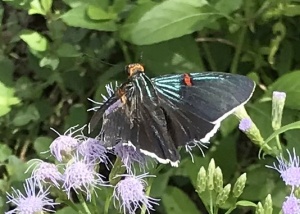
Many, many Gulf fritillaries keep close to the passion vines.
No monarchs sighted yet. Anyone have any monarch butterflies coming round?
A mystery butterfly or moth lingered on a scarlet sage bloom this week. If anyone knows what it is, I’d really appreciate your letting me know. I’ve never seen anything like it. It was smaller than my little fingernail. It was red, or deep pink, with white head and legs.
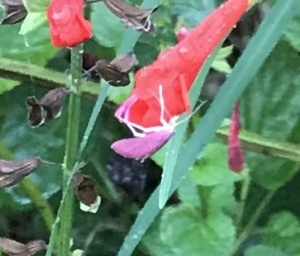
Back to the One-stop Shopping Tree-planting Time in the Valley. November through February is the optimal time to plant trees here. You’re probably familiar with the mantra: Cooler temps allow trees and shrubs a dormant period when roots can grow without the stress of heat and drought. Plants will be more established and flourish with spring rains.
Of course, many of us plant whenever we see something we want. This time of year, we generally don’t have to spend as much time encouraging something to establish, as we would during June, July and August.
If you haven’t yet given thought on how to increase your native habitat, here are a few suggestions. I call it One-stop Shopping. Not for us, one-stop shopping for birds, insects and critters.
The first five are old standards but, if you have the room, give them a consideration if you don’t already have them. They have valuable benefits and really increase the wildlife.
Anacua, Ehretia anacua
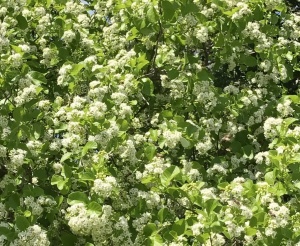
• Blooms spring and after rain
• Nectar – butterflies, bees and other beneficial pollinators
• Fruit – food for birds and other wildlife
• Edible berries – yellow are tart, orange are sweet — spit out the seeds
• Nesting and shelter for birds and critters
• No thorns
• Leaves like sandpaper
• Can grow to 40 feet
• Keeps leaves all year
Texas Ebony, Chloroleucon ebano
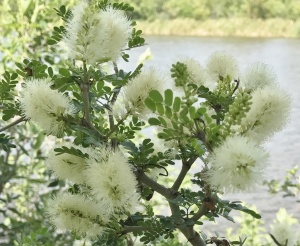
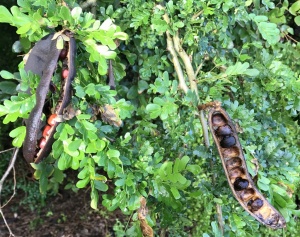
• Can reach 50 feet tall
• Keeps leaves all year
• Blooms summer and after rain
• Magnitude of short, paired spines
• Slow growing — but not too slow
• Wild life – cover, roosting, nesting sites and protection for birds
• Host to some Sulfurs, Blues, Skipper butterflies
• Javelina, deer, small mammals and insects eat leaves, seed pods, seeds
• Flowers – bees, butterflies and other beneficial pollinators
If you’re so inclined: Ebony is an excellent specimen for an indoor bonsai – can grow from cuttings
Wild Olive, Cordia boissieri
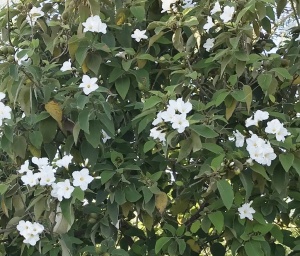
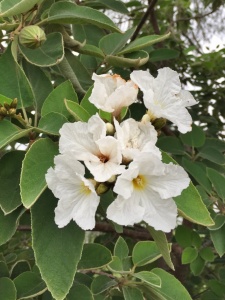
• Native to Lower Rio Grande Valley
• Drought tolerant
• Keep as shrub or lop off lower branches for a tree shape
• No thorns
• Important nectar – hummingbirds and butterflies
• Fruit is food for wild animals and birds
• Leaves consumed as forage
• Edible fruit (keep it to possibly one – toxic; may cause (brief) intestinal distress
o Not good near a walkway, gelatinous fruit; slick when stepped on
• Indigenous people made jellies and dyes from fruit
• Leaves – medicinal tea – rheumatism, bronchial congestion
• Blooms through all seasons
Granjeno, Spiny Hackberry, Celtis pallida
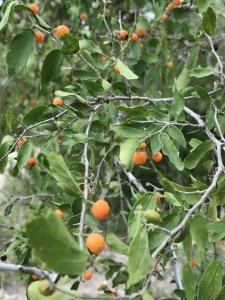
• Shrub or small tree
• To 20 feet
• Blooms in spring
• Paired spines (wicked)
• Zigzag branches
• Leaves have serrated edges
• Feeds birds and mammals
• Host to American Snout butterfly
• Fruit is edible raw
• Jams/preserves
• Dried and ground into a nutritious meal
• Prolific self- and bird-propagation
• Excellent in a “native” security fence
If granjeno grows too closely to a mesquite, both can vie for sun, space and nutrients, and tangle themselves together vine-like to amazing lengths — Granjeno clippings are erratically shaped and springy with wicked spines. Still, provides great bird food.
Sugar Hackberry, Celtis laevigata
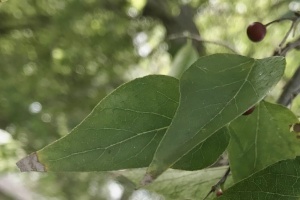
• More polite than it’s thorny cousin; no thorns, spines or prickles on sugar hackberry
• Edible fruit. Can be eaten straight off the tree – spit out seeds
• Berries are smaller than spiny hackberry berries and darker red when ripe
• Leaves have smooth edges
• Sugarberry syrup
• Skin, berry, seed – dried, ground and added to other flours for greater protein
• Excellent bird food
Next is a tree I’ve grown to appreciate this year after researching it to some length.
Brasil, Condalia hookeri
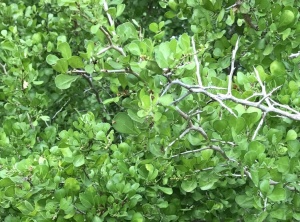
• Vibrant, lime-green leaves – can easily be picked out of a line-up (of trees)
• Tolerates drought
• Full sun
• Dry, well-drained soils of sandy loam, clay or caliche
• Heights to 30 feet; usually smaller in our area
• Leaves remain all year on light-gray branches until new leaves begin pushing out in spring
• Tiny green flowers bloom summer and fall
• Green berries turn red, then black when ripe
• Blooms and fruits at the same time offering food for wildlife through two seasons
• Sweet, edible berries — popular for making jelly and wine
• Coyotes, raccoons, squirrels, opossums and quail also vie for the coveted berries
• Leaves browsed by deer
• Protection to birds for roosting and nesting
• Branch tips end in sharp thorns
• Security hedge possibilities – impenetrable thorny thicket keeping humans at bay while sheltering small mammals, quail and other critters from predators.
• Bluewood Condalia is another name because of the blue dye Native Americans obtained from the wood
• Ripe fruit makes purple dye
• Wood also was used for fuel
• Grown from cuttings, seeds collected from ripe fruit or plants purchased from local native plant growers.
The tree listed below is on my wish-list. I should quit procrastinating as it’s an incredibly slow grower in its native habitat of brushlands (and I’m not getting younger). I’ve heard specimens are larger on resaca banks in Cameron County. We have some magnificent specimens in Harlingen’s Hugh Ramsey Nature Park. Perhaps a tree would grow quicker if nurtured.
Guayacán, Guaiacum angustifolium
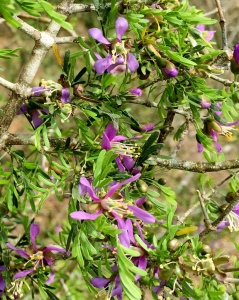
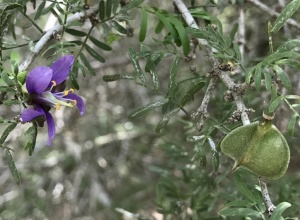
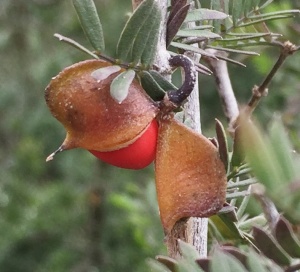
· Very slow growing – 8 to 20 feet
· Sun to partial sun
· Well drained, poor to rocky soil and adaptable to any type you have
· Native in south Texas to northern Mexico
· Drought tolerant — deep taproot
· Very high heat tolerant
· Dense, small leaves on knotty gray stems
· Leaves fold up at night and mid-day to conserve water
· Keeps leaves all year
· Crooked growth form, give it plenty of room and let it take on its natural shape
· Flower clusters from March through September, usually after rains
· Blue/violet/purple flowers – fragrant
· Small, heart-shaped seed pods, turn a rich cinnamon color when ripe and pop open to reveal strikingly bright red, hard seed about the size of a pinto bean
· Excellent cover for wildlife
· Host to lyside sulphur butterfly and gray hairstreak butterfly
· Nectar for bees and insects, nesting sites, browsed by deer, fruit for birds and mammals
· Seed propagation, but difficult; digging up in the wild, impossible — remember about the long taproot
Berlandier’s Fiddlewood, Citharexylum berlandieri
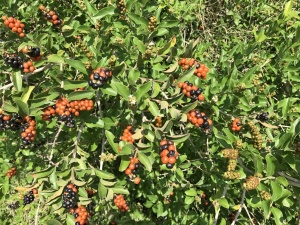
• Only in the Lower RGV (and south to Mexico)
• White flowers
• Flower and fruit all year
• Some plants bloom but bear no fruit. This is rare — buy two or three to be safe.
• No thorns
• Plant in full sun
• Nectar for butterflies and other beneficial pollinators
• Host to possibly the common buckeye butterfly
• Berries in clumps. Greenish, then red, and black when ripe
• Great bird food
• Perch for birds
• Wind/dust break
• Upwards of 6 X 6 feet
o This wouldn’t mind being a stand-alone shrub; in the right conditions, it could take up an entire garden
• Edible fruit, some think taste like dates
• Can prune; it’ll slap you in the face and laugh at you
Barbados Cherry, Manzanita, Malpighia glabra
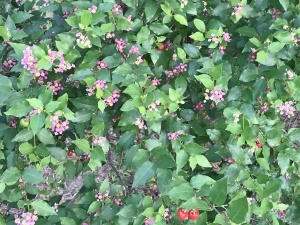
• Nectar
• Berries for birds
• Not armed
• Grows to 6 feet or taller
• Can handle occasional pruning
• Very high heat tolerance
• Full sun to partial shade
• Little maintenance
• Flower and fruit throughout the year
• Host to Skippers and Blues
• Flowers eaten raw or used as a tea
• Fruit edible – richest source of vitamin C — spit out the seeds
• Fruit – juices, sauces, jellies pies, wine
Skeleton Leaf Golden Eye, Viguiera stenoloba
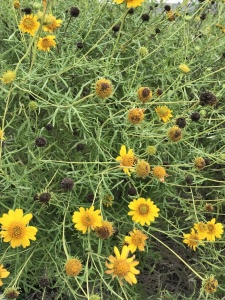
• If left on own, full, shapely, small shrub; lower branches cover the ground
• Provides excellent cover for wildlife
• No thorns
• Nectar for bees, butterflies, moths, insects
• Seeds for granivorous birds
• Nesting sites
• Full sun to partial shade
• Dry, rocky soils to clay loam and caliche
• Requires good drainage
• Grow to 4 feet
• Spreads 3 to 4 feet
• Winter hardy – leaves evergreen
• Blooms most of the year if deadheaded
• Exceptionally drought-tolerant
• Blooms more with a good watering schedule
• Can keep it blooming if 6 inches of dead blooms are sheared off periodically
• Stash clipped debris under the shrub for soil nutrients and seed-eaters
• Makes a nice (tallish) ground cover
• Aromatic oils in leaves help deer avoid it
These are my picks for planting to help nature take care of itself and provide me with beauty and entertainment.
What are your favorites?
Possibly the mystery insect:
https://www.butterfliesandmoths.org/species/Pyrausta-inornatalis
That’s IT! How wonderful! Thank you so much! Love the name, Southern Pink Moth. Really grand of you to solve that mystery for me! Thank you.